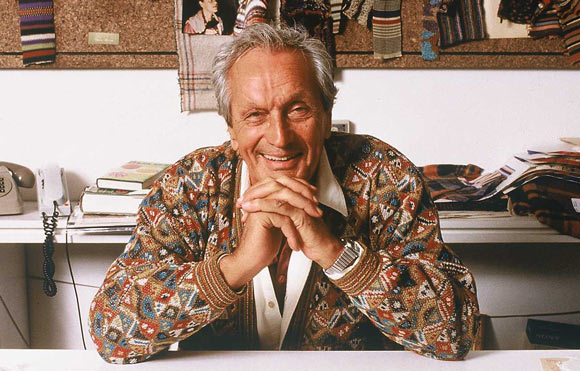
Born on February 11, 1921, Ottavio Missoni was the founder of Missoni and represented Italy, as the hurdler in 1948 Olympics. Along with his wife, Rosita, Missoni was among the group of designers who introduced the Italian pret-a-porter in 1950s, ensuring the worldwide success of the fashion scene in Italy.
He washborn in Dubrovnik on the coast of Dalmatian. His mother, Teresa de Vidovich was the Countess of Rogoznica and Capocesto and his father, Vittorio Missoni was a sea captain from Friulian. Ottavio completed his education in Milan, Trieste and Zara.
Ottavio had a sporty personality – at the age of sixteen, in 1937 he enrolled in the Italian National Track Team. He was the winner of the solo national championship over three times. Moreover, he competed in 1948 Olympics with the Italian team. Around this time, he met Rosita Jelmini who was sixteen year old and studied at Golasecca. She was among the audience when Ottavio was in his final run. Five years later, the two married and resided in Gallarate. They had three children: Vittorio (1954), Luca (1956) and Angela ( 1958).
This sportiness was only present when he was young but even at the age of eighty-eight, Ottavio used to playing sports like javelin and shot putting.
Apart from being mere sportive, Ottavio served during the Second World War as an infantryman. In 1942, he participated in the Battle of El Alamein, and the Desert rats captured him. Due to this, he had to spend the remainder of the conflict in a prisoner of war camp in England.
Once the war was over, Ottavio and Giorgio Oberweger (team-mate) launched a collection of active-wear in Trieste creating tracksuits titled Venjulia suits. These creations were made from using techniques such as drop stitching, ribbing and zippered legs. It became a huge success among athletes and was considered best for moving freely. Thus, the suits were worn in the 1948 Olymics.
In 1953, after his marriage, the Missoni family established a machine made knitwear workshop, Maglifico Jolly, in Gallarate. Otttavio’s experimentations highly benefited the bedspread and shawl making industries. His designs were distributed to departmental stores like Milan’s La Rinascente. Here, his line of garments and colorful shirt dresses were also displayed. His active-wear designs contributed considerably to the advancement of the American sportswear industry.
By 1965, his work was being talked about in the media. Anna Piaggi wrote an article about him for Arianna magazine printed by Mondadori. She promoted Missoni continuously throughout her career in fashion journalism. The write-ups included press releases while she working for Vogue Italia in 1980s. Her attempts to make people aware of Missoni’s work was a hit and soon the designer became prominent among the world. Another reason for his popularity was his collaboration in 1965 with Emmanuelle Khanh. The two had their debut show in 1966 and the next year displayed work in Florence at the Palazzo Pitti. The show was not well-received and was scandalized. With this they got publicity and continued towards Milan.
Missoni’s work was featured in several leading fashion print media such as Harper’s Bazaar, Elle, Marie Claire, Vogue and Women’s Wear Daily.
In 1997, the couple passed their business to their kids, giving them the opportunity to work with the traditional Ottavio Missoni brand and make it work in the contemporary world.
In 2013, after their sixtieth wedding anniversary, Ottavio was rushed to the hospital. However, at his request he was taken back home to his family where he soon died at the age of ninety-two.